UPDATED! This blog post on content ideation has been updated and vastly expanded for 2020!
Effective content marketing is a long-term strategy. Companies that enjoy the highest ROI on their content marketing investment typically publish quality content consistently over long periods.
However, after a certain amount of time publishing content, it can be difficult to come up with new blog post ideas that will resonate with your audience.
Rest assured that there are a never-ending number of topics that companies in any industry can cover – as long as you employ a little creativity. It’s easy to get stuck when it comes to content ideation and feel like your brand has covered everything under the sun.
But don’t worry! In this post, we’ll cover 30 ways that any content marketing manager can break through writer’s block and come up with new ideas for high-value content that resonates with their audience.
Be sure to bookmark this post and come back whenever you’re in need of a little inspiration!
1) Check Out Other Industry Blogs
Let’s start with an easy one! The best way to ideate new topics for your company blog is to simply take a look at the industry landscape. What are other blogs publishing? What kinds of topics are working for them?
Study the blogs in your industry that publish for a similar audience and take note of topics that you have yet to cover. Of course, don’t copy their topics down to the letter (and never, ever copy their content word for word!); just use that research as a jumping-off point.
This idea is what Brian Dean’s skyscraper technique is all about: You look at what other blogs are covering and figure out a way to write about a similar topic in a better way.
What does better mean?
- Maybe yours is longer with helpful screenshots
- Maybe yours includes up-to-date info
- Maybe you add your own research
- Maybe you cover the topic from a different angle
Whatever angle you use, just improve the original topic.
Use popular industry blogs as a guidepost for the content that you create. Keep an eye on what resonates with your audience and find ways that you can uniquely cover those same topics, only better.
Dive Deeper: The Skyscraper Technique: How to Build High-Quality Backlinks to Your Content
2) Expand Existing Content
You may not have to come up with new blog ideas after all.
Google favors fresh content, meaning content that has been recently published or recently updated. Updating old posts that are already performing decently in organic search but have simply seen a decline in traffic is a great shortcut to ramp up that organic traffic.
Take a look at this image from ClickFlow that shows how fresh content degrades — or “decays” — over time and becomes less successful for certain search queries, particularly those that are somewhat newsworthy or trend-based:
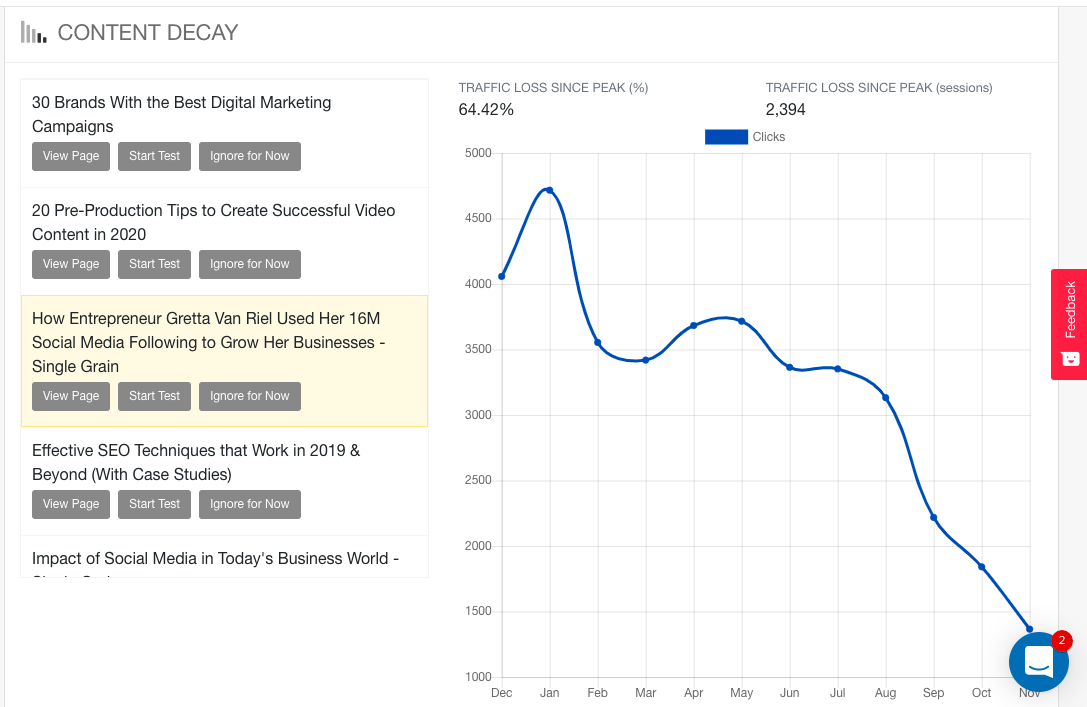
Updates are particularly important for topics that change over time, because Google wants to make sure that they are connecting searchers with the most up-to-date information.
Updating old content can help you:
- Improve your click-through rate
- Fix mistakes in previously published content
- Show Google that your content is fresh
- Add new, relevant context
- Replace broken links
- Update statistics and facts with current sources
If you’re having a hard time coming up with new topics, try identifying under-performing blog posts and giving them a bit of a refresh.
Learn How to Here: What Is Content Decay and How It Affects Your SEO
3) Ask Your Network for Ideas
Your network is a unique tool in your tool belt.
Reach out through email, social media or in person to figure out what topics they would be interested in reading about. Pay particular attention to suggestions from industry colleagues as they will have unique insight into your industry and might be able to identify more obscure pain points to cover for your audience.
If you haven’t already, join or create specific mastermind groups or online communities to regularly network and get inspired by your industry peers.
Marketers don’t lean heavily enough on their network for ideas, but they can be a great resource for content ideation to generate insightful ideas while developing closer relationships in the process.
Dive Deeper: 8 Slack Communities Every Marketer & SEO Should Join
4) Follow Influencers
Who are the influencers in your industry? Identify popular bloggers and social media profiles that are a hit with your audience. These could be individuals or brands.
Examine what kind of content is gaining traction with their following. These could be blog posts or smaller pieces of content like social media updates.
A great tool for identifying relevant influencers across social networks is Upfluence, which provides a searchable database of more than 3 million influencers, along with tools for outreach:

Anything that generates a conversation with your audience is a safe bet for a blog post. Later you can let the influencer know how their content inspired your blog post and maybe they’ll share it with their following.
Dive Deeper: How to Grow Your Business with Influencer Marketing and Brand Partnerships
5) Ask Your Customers
Is there a better source of information than straight from your target audience?
You are creating content for your customers and prospects, after all, so don’t be afraid to ask them what kind of content they would be most interested in. They’ll love to hear from you!
Ask questions that are centered around problems that they are currently having and create detailed, solution-oriented content about those issues.
You can reach out and engage in a conversation with customers one-on-one or you can send out a survey to a wider group. Either way, use those answers from your customers to crowdsource blog post ideas.
A great tool for quickly creating customer surveys is SurveyMonkey:

Your customers are your best resource for content ideas. Ask them directly what they want to read/learn about from you.
Dive Deeper: Top 8 Tools to Improve Customer Experience Using Heat Maps, Feedback and Links
6) Brainstorm with Your Sales Team
The only people who might have nearly as much insight into your customers’ problems as the customers themselves is your sales team. After all, they speak with your audience every day, working to better understand their needs so that they can position your products as the solution to those problems.
You can send out an email to the sales team, but it might be more effective to schedule a meeting. Being able to have everyone in the same room to bounce ideas off of one another can help to surface some great content ideas that would otherwise stay buried.
Work with your sales team to brainstorm sales enablement content that will help them to close more deals:

Dive Deeper: Why Every Business Should Implement Sales Enablement
7) Talk to Your Customer Support Team
Customer retention is arguably more important than bringing in new customers. According to ReSci:
- The probability of converting an existing customer is 60-70%.
- The probability of converting a new prospect is only 5-20%.
There is no one that has more direct contact with your customers on a daily basis than your customer support and customer success teams. They will intimately know the problems that your customers face with your product and can be an invaluable resource for content creation ideas.
Hosting regular meetings with your customer support teams will not only help you to come up with new content ideas, but will help you flesh out other areas of your content strategy such as support documentation and post-sales educational content.
Dive Deeper: 4 Bullet-Proof Ways to Increase Customer Retention (and Increase Sales!)
8) Use Your Most Successful Posts as a Guide
No need to reinvent the wheel! What’s worked for you in the past?
Do you have any posts that have performed exceedingly well in organic search or have gained a lot of traction on social media? Use that success as a sign that the topic you covered might be worth investing in further.
Go to Google Analytics, take a look at your posts that have done well and brainstorm new ways that you can cover and expand upon the topic to create value for your audience:

For instance, if this post performs well, we might come back to it in six or twelve months and add more tips or flesh specific tips out in their own article.
Dive Deeper: Absolutely Everything You Need to Know About 10x Content
9) Collate Advice from Industry Leaders
Who better to advise your audience than experts on the topic that you are covering? That’s the essence of thought leadership.
Not all content has to be advice from you or your writing team; you can source content from others. Often, industry leaders will be happy to provide some insights on topics that they know about, as long as you credit them and give a link back to their website.
You can also ask leaders and experts to write a guest post for you, as we often do. For example, PlaybookUX CEO Lindsey Allard wrote an epic, 7K-word post for us called How to Use UX Testing to Improve Your Customer Lifetime Value (CLV) that came from her unique knowledge and experience.
Companies like Databox have taken this practice to the next level, collating dozens of tips or insights from industry leaders into a single article. This also has the added bonus of giving all the contributors the incentive to share it with their own audiences.
Dive Deeper: 4 Ways to Signal to Google that You’re an Expert Content Creator
10) Interview an Expert
Take the previous tip a step further and set up a full interview with an industry expert.
A quick 30-45 minute call can provide a lot of insight on most topics. Then you can use the advice, tips and knowledge that they deliver to write an article.
Being featured in a blog post is an enticing prospect that most experts would be happy to jump on – and they’ll also be glad to share the article with their audience once it is published.
A great tool for conducting and recording interviews with experts is Zoom, which is free to use (but keep in mind that it has a meeting limit of 40 minutes for more than two participants – i.e. you and one guest – unless you upgrade to a paid account):

Dive Deeper: 8 Videos You Can Generate from One Interview with Your CEO
11) Analyze Your Newsletter Performance
If you send out regular emails to your subscribers, use that data to guide you toward future topics. Which email subject lines had the highest open rate? What emails generated the highest click-through rate?
Your newsletter subscribers are a critical component of your audience. Data from those email campaigns can be very useful to help you better understand your audience and hone in on topics that are important to them:
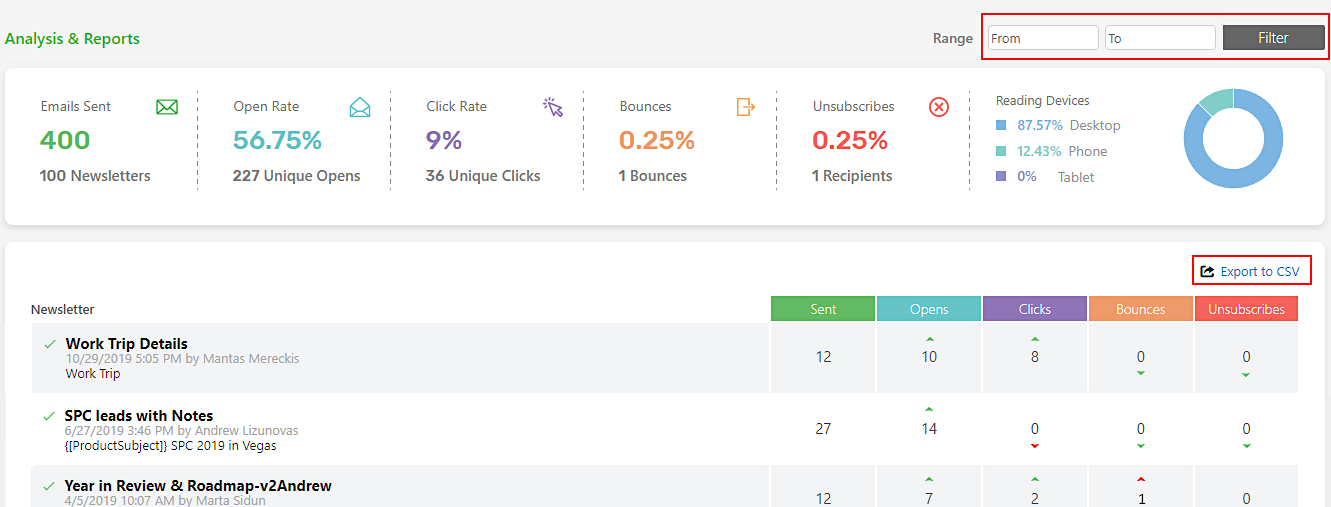
Dive Deeper: Beyond the Newsletter: You’ve Got Their Email, Now What?
12) Pull Stories from Real Life
Storytelling is powerful.
92% of consumers want brands to deliver ads that feel like a story, and there are no stories that you know better than your own.
You can tell a personal story from your own professional life, a story from your brand’s perspective, or a story about another member of your team. The “moral” of the story — or the takeaway — is generally how you learned something, how you grew, how you bounced back from a mistake, why you decided to start a podcast or a company, etc.
You’re not just telling a story, but you’re providing something of value for the reader.
If you have any interesting, insightful or inspiring stories — and I guarantee that you do — this can provide a simple and direct way to make a more personal connection with your audience.
Dive Deeper: How We Built the Growth Everywhere Podcast to 109,000 Listens per Month
13) Share Your Successes
People love to read a step-by-step account of a path to success.
If your brand (or a member of your team) was able to achieve a recent success, share that with your audience. If you can, take them on the journey and show the specific steps that you took to reach your goal.
Sharing your successes makes your brand more human. It allows your audience to become aware of the work and preparation that goes into achieving those heights and can serve as a blueprint for other entrepreneurs and startups.
Here’s a great example of a step-by-step article that shares success from Chanty. Their blog post details how they used content marketing to grow their organic traffic and generate more than 10,000 leads for their SaaS software solution:

14) Share Your Failures
Sharing successes can provide your audience with a roadmap for achieving those same successes themselves. Sharing your failures serves much the same purpose, but for opposite reason.
As with successes, sharing failures can help humanize your brand. It makes you real. It makes you relatable. It also allows you to show others the mistakes you made so that they can avoid them if they are going down a similar path.
We have a number of posts on the Single Grain blog about the mistakes we made — our SEO mistakes, keyword mistakes, marketing failures, taking on too many clients — all with the desire to help other marketers, entrepreneurs and business owners grow faster and more efficiently.
Here’s a great example of sharing your failures from Codeless, in which their founder shares the biggest mistakes they made on their way to surpassing $70k MRR:
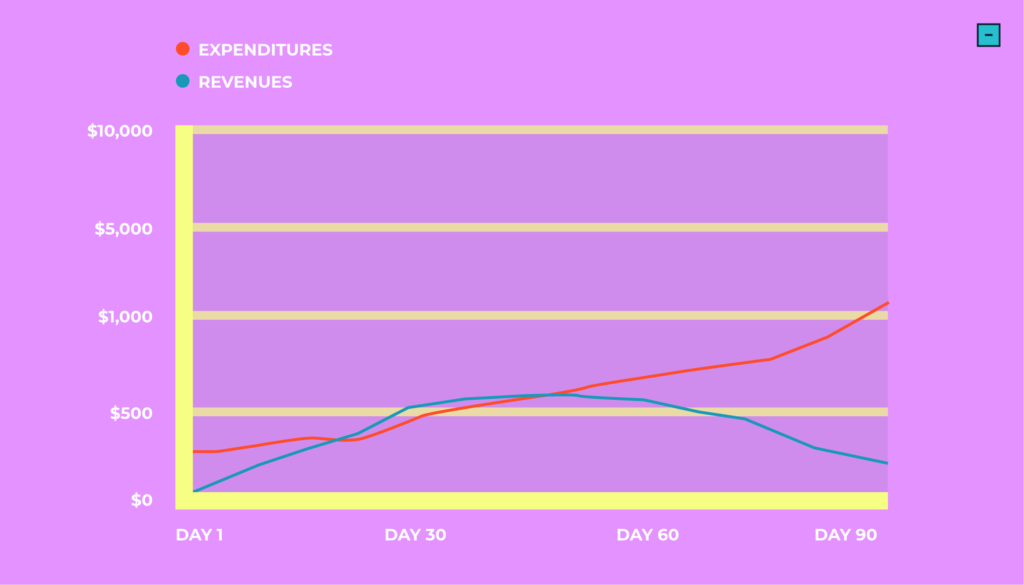
Dive Deeper: Some of My Biggest Marketing Failures (And What You Can Learn From Them)
15) Ask Your Co-Workers What They Want to Write
Your internal teams can be a great resource for content topic ideation — or even to write a blog post themselves.
Every department has a unique perspective that leads to unique insights that your audience might find helpful. We are always open to having our team members from any department write a post on something that they think would be of value for our readers.
For example, our Paid Advertising Manager Justice Ekhaguere had an idea about the importance of a brand persona when it comes to a company’s success, so he wrote How a Brand Persona Plays Into Effective ROI.
He wrote from his personal point of view, which meant using language like: “Back when I was an intern in my first strategy session, our client made a really confusing comment right before the presentation that’s stuck with me to this day…. Not until I learned about the concept of brand personas did that comment finally made sense to me.”

Find co-workers who have something interesting to share with your customers. That story could be about them personally or an aspect of their job, so long as it is a topic that your audience would find interesting and insightful.
Another great post from our team: Geotargeting: How to Find the Right Customers for Your Brand
16) Crowdsource Content
There is nothing wrong with curating content from other sources, so long as the content that you share provides real value to your audience.
Scouring articles, communities and social media to find interesting content on topics that are relevant to your readers can be a great way to quickly provide an overview of a specific topic.
For instance, if you were reviewing a specific piece of software, you could collect useful reviews from sources around the web to give your audience an idea of what other customers have found positive and negative about their experience with that company. Another example would be collecting insightful answers to specific questions from forum sites like Quora.
Additionally, digging through your company’s reviews from your own customers can be helpful for identifying new blog topics and finding customer pain points:
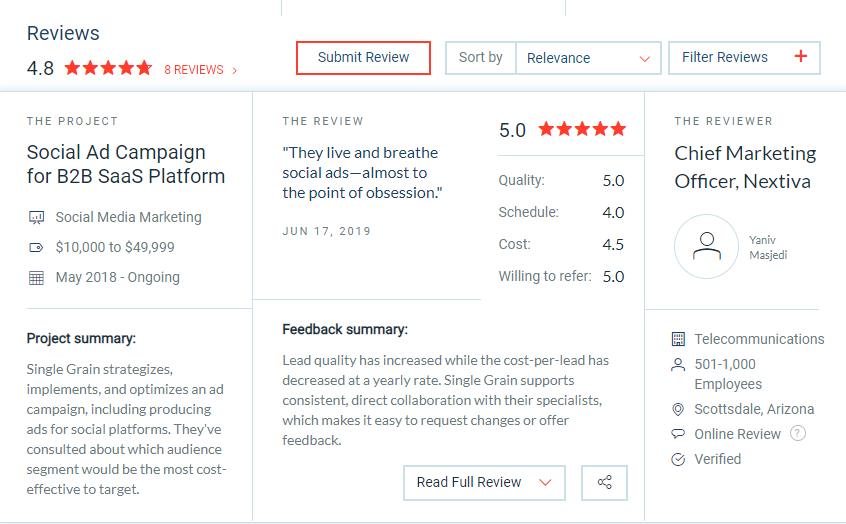
17) Leverage Blog Comments
The readers that comment on your blog posts are the most engaged members of your audience. Use them to your advantage.
Take a look through the comments that have been left on your posts over the last year or so. Take note of any topics that you see mentioned multiple times, complex questions that could inspire a new post or unique viewpoints that might inspire content ideas.
Also, take note of the topics that have the most comments and general engagement, then find unique angles for those topics:
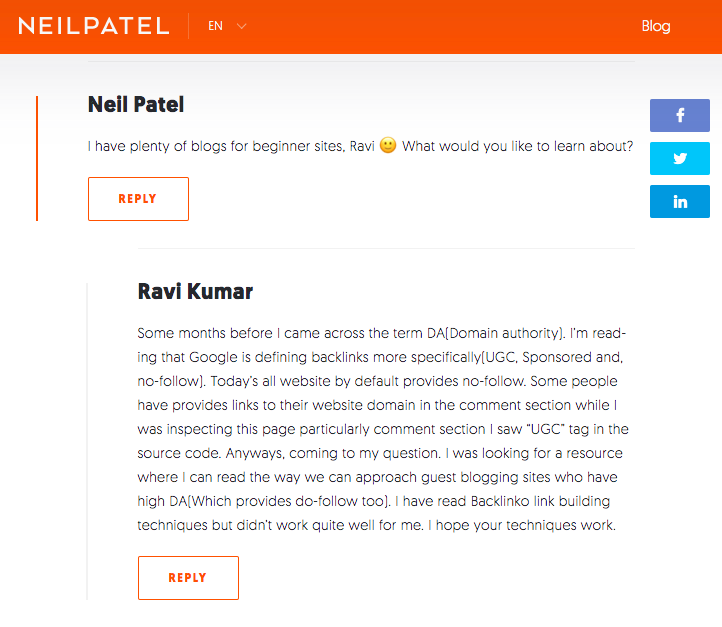
Dive Deeper: 30 Social Media Prompts to Get the Conversation Started
18) Turn Your FAQs into Blog Posts
The reason why any company writes a page of frequently asked questions is because they’ve highlighted the issues and questions that a majority of their customers ask on a regular basis.
So why not take your FAQ page one step further and create individual blog posts for any question that merits a longer response? Add screenshots or other images to help illustrate the instructions or points that you are giving. Embed a short video when one or two screenshots is just not enough. Create a fun or helpful GIF for a quick 3-5 frame “video”:

Then be sure to link from FAQ page to the specific blog post, and vice versa.
19) Create a List of Niche Resources
If you’ve been publishing content for any length of time, there is a pretty good chance that you’ve published a resource list before. In fact, you’re reading one now. 😀
We’ve compiled plenty of different resource/list posts:
But consider the customer personas that your company caters to. A list of social media tools, for instance, might be somewhat useful for all of your personas, but honing in on tools for a specific persona would make for an incredibly valuable piece of content for that specific segment.
For an example, if one of the buyer personas that your company targeted were mid-level real estate agents, creating a post on the best social media tools for real estate agents would be very useful for them and would give you a unique way to approach a familiar topic:

Dive Deeper: 9 Tools for Easy Competitive Website Analysis
20) Use Google Autocomplete
Google autocomplete can be a legitimate goldmine for content ideas.
Start by typing in key phrases that are related to the types of content that have traditionally performed well for your brand.
Take note of the suggestions that pop up. Then search for those key phrases and see what types of content are being published on those topics. For example, in this example below, you might be able to write a blog post on how to troubleshoot autocomplete in Firefox or a humorous Buzzfeed-type post on the top 10 funniest autocomplete discoveries.

Think of Google autocomplete as a content brainstorming engine.
21) Identify Growing Interest in Google Trends
When it comes to organic content strategy, there are few things more beneficial than making an investment in a topic that will grow over the next few years.
Identifying organic keywords that are sure to become even more popular within the near future is incredibly valuable and can give you a leg up on the competition.
Google Trends allows you to see the historical search popularity for any keyword term. Search for industry keywords to identify topics with growing interest:

You can also use another tool called Exploding Topics that “surfaces rapidly growing topics before they take off”:
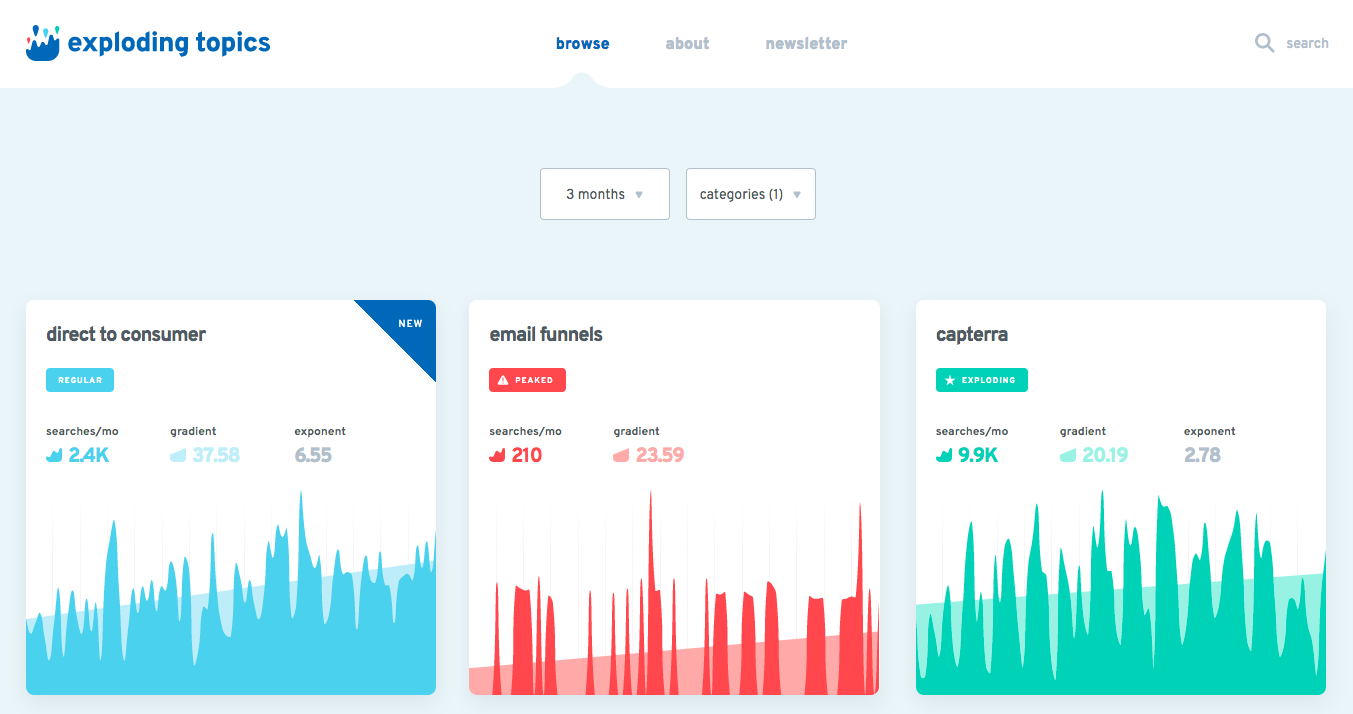
22) Use BuzzSumo to Analyze the Competition
BuzzSumo allows you to identify blog posts that have performed well in your industry.
Using their tool, you can see the articles that have had the most social shares for any topic. Enter a keyword and see the most-shared articles that include that keyword in their title.
Additionally, you can use BuzzSumo for competitor research:
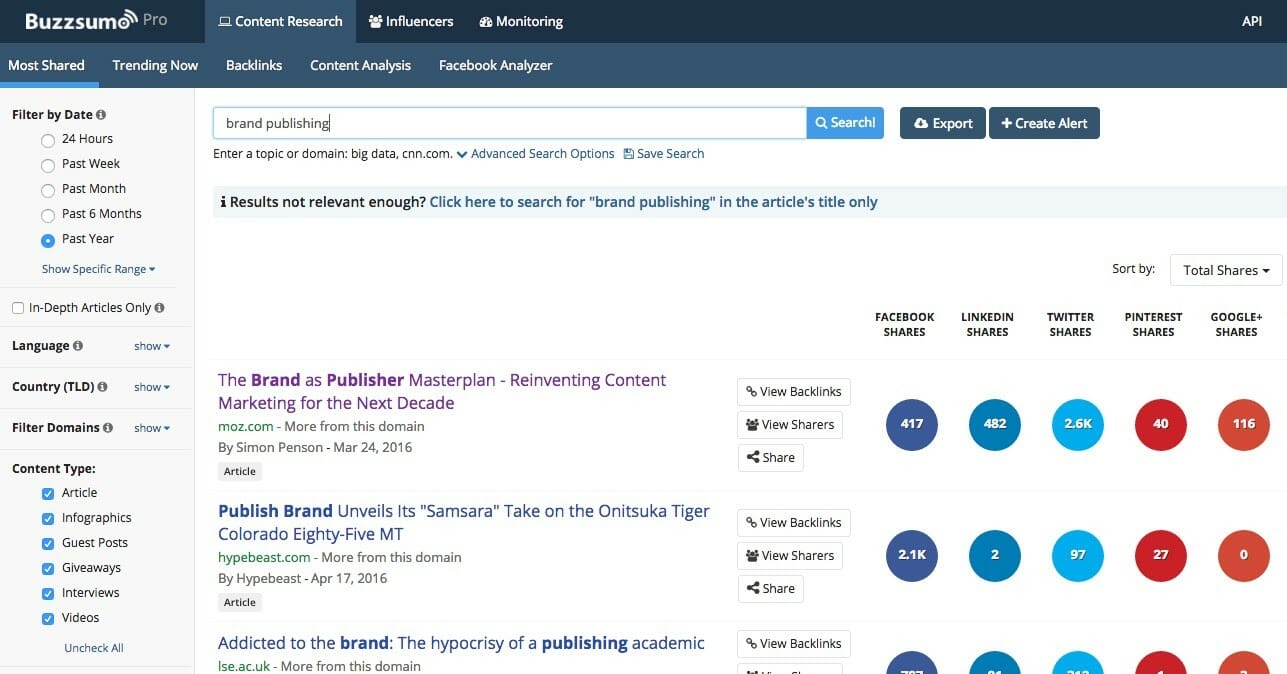
Just enter a competitor’s URL to see which of their content pieces has been shared the most on social media. Then you can zero in on topics that have performed well for your competition and create content around those topics.
Dive Deeper: How to Uncover Your Competitors’ Content Strategy
23) Use Social Listening to Identify Pain Points
What is your audience saying about your product? Or your industry? Or your competitors? What questions are they asking? If you don’t have a social listening program in place it is impossible to know the answers to these questions.
Social listening allows you to identify the pain points, interests and needs of your audience outside of your owned channels. Not only will it help you to identify effective blog topics, but it will also give you a more well-rounded view of what your industry as a whole thinks about certain topics.
A great tool for social listening is Keyhole, which allows you to monitor keywords that are relevant to your brand across the Internet and not just on social networking sites:

Another free solution is Google Alerts:
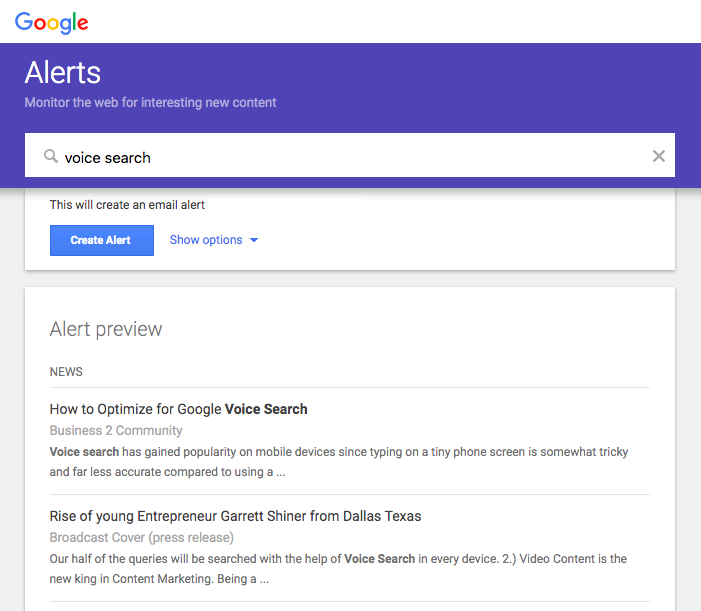
24) Use Google Keyword Planner to Create Content
Google Keyword Planner is a free keyword research tool that helps you find new keyword ideas for your Google Ads, but it can also be a very useful tool for keyword research for content creation and SEO purposes.
The Keyword Planner has two main tools:
- Discover new keywords – to “get keyword ideas that can help you reach people interested in your product or service.”
- Get search volume and forecasts – to “see search volume and other historical metrics for your keywords, as well as forecasts for how they might perform in the future.”
You can enter your seed keyword(s) to come up with variations (via the “grouped ideas” feature) to inspire different angles for potential blog posts. For example, entering the keyword “PR Pitch” comes up with nine different ideas:
- PR pitch example
- Pitch PR
- PR pitch email example
- Fashion PR pitch example
- PR pitch email
- Best PR pitches
- Writing a PR pitch
- Pitch PR agency
- PR agency pitch
Learn: How to Use Google Keyword Planner for Content Creation
25) Find Content Gaps with Ahrefs
Most companies approach competitor content from the angle of identifying what has been working. There’s value in that, of course.
But you should also dive into where the gaps are in your competition’s strategy. What topics have they failed to cover? What topics have they covered, but not so well? In identifying gaps in their strategy, you can create blog posts on those topics and create a more well-rounded content operation.
Ahrefs offers its “Content Gap” feature, which allows you to compare your site (or a competitor’s) to other sites in your niche to identify keywords that you are not currently ranking for:

26) Monitor Facebook Groups
Facebook Groups are an absolute hotbed for genuine industry conversations.
Identify popular groups where your prospects and customers hang out and monitor the conversations that they have. You can learn a lot from seeing what your prospects say to each other.
Try to target private groups. While there is some value in reading public Facebook Groups, private groups tend to be better moderated and thus have more interesting and insightful conversations.
Luckily, finding groups is pretty simple. Just type a keyword into the standard Facebook search bar at the top of the page. When that loads, select “Groups.” Groups that are relevant to the keyword will be displayed and will also provide some stats to give you an idea of how active each group is:
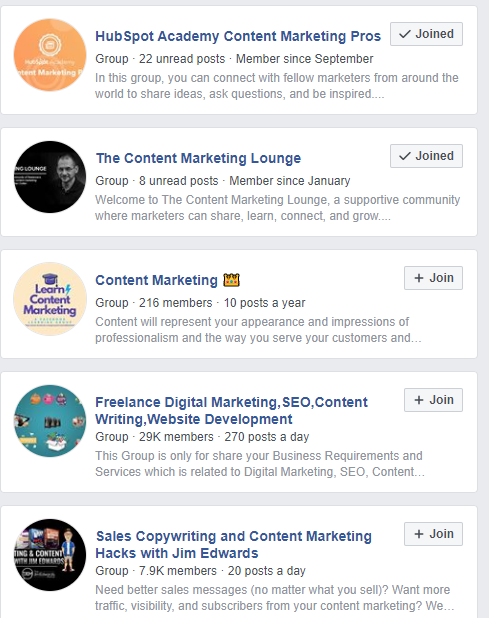
Dive Deeper: 12 High-Performing Facebook Group Engagement Tactics
27) Turn a Product Demo into a Step-by-Step Blog Post
Although we mentioned earlier about including short videos or screenshots into a blog, you can also turn a product demo or other type of “how to” video into a blog post.
Much has been said on how everyone would rather watch a video to learn something than read a blog post, but the truth is that blogs are still a much-used resource. Consider this:
In March of 2019 – just one month – 4.4 million blog posts were published every day. And 409 million people read more than 20 billion pages on WordPress each month.
Take a detailed product demo, explainer video or even short webinar, get the transcript from a service like Rev, and turn that into a step-by-step guide with screenshots from the video to illustrate each step.
Dive Deeper: 9 Ways to Repurpose Your Old Blog Content
28) Create a Roundup of Popular Posts
Sometimes you don’t even need to write content to create content. There is a lot of value in curating content as well.
Collect the best recent posts from around your industry. Don’t worry if there are some competitors in there, just focus on sharing the best possible content for your audience. Although they may wind up following or bookmarking other sites, there’s a very good chance yours will be the one they return to on a regular basis since your roundup will give them multiple posts in one post.
We created a weekly digital marketing roundup called, quite simply, This Week in Digital Marketing: A Roundup.
Not only is this a simple type of content that you can create consistently, but it will also help you build relationships with other industry brands. And once you get a bit of traction, you’ll find, as we did, that people will start asking you to include their blog post in your roundup.
29) Source Ideas from Podcasts
Podcasts are the popular new kid on the block when it comes to content marketing. We’ve seen a groundswell of support for podcasts and you have probably seen more brands within your industry launching their own.
You can use this to your advantage. Take a look at some of the topics that the most popular podcasts in your industry focus on and use those for inspiration for your own content.
Stitcher is a podcast aggregation library that makes it easy to discover new podcasts. Go through their category listing or search for a specific topic, and then quickly scroll through episode titles:

Or if you have a favorite podcast in your niche, like Marketing School, you can scroll through their past episodes:

Dive Deeper: 10 Best Marketing Podcasts to Help You Grow Your Business
30) Pull from Your Own Research or Statistics
Publishing statistics, studies and facts about your industry can be a great way to generate traffic.
Content that focuses specifically on a list of useful and current statistics can serve as an excellent resource. They are a great way to encourage backlinks, as other brands will cite the statistics that you have published on your blog.
Just make sure that they are current, useful and relevant to your niche or industry.
Say Goodbye to Blog Topic Writer’s Block!
This list of 30 ideas to come up with great blog topics should help you get started writing the blog posts that your audience will find interesting and valuable.
Content marketing is a long-term strategy. Having a defined process for topic brainstorming will serve you for years to come and keep the content treadmill turning!

